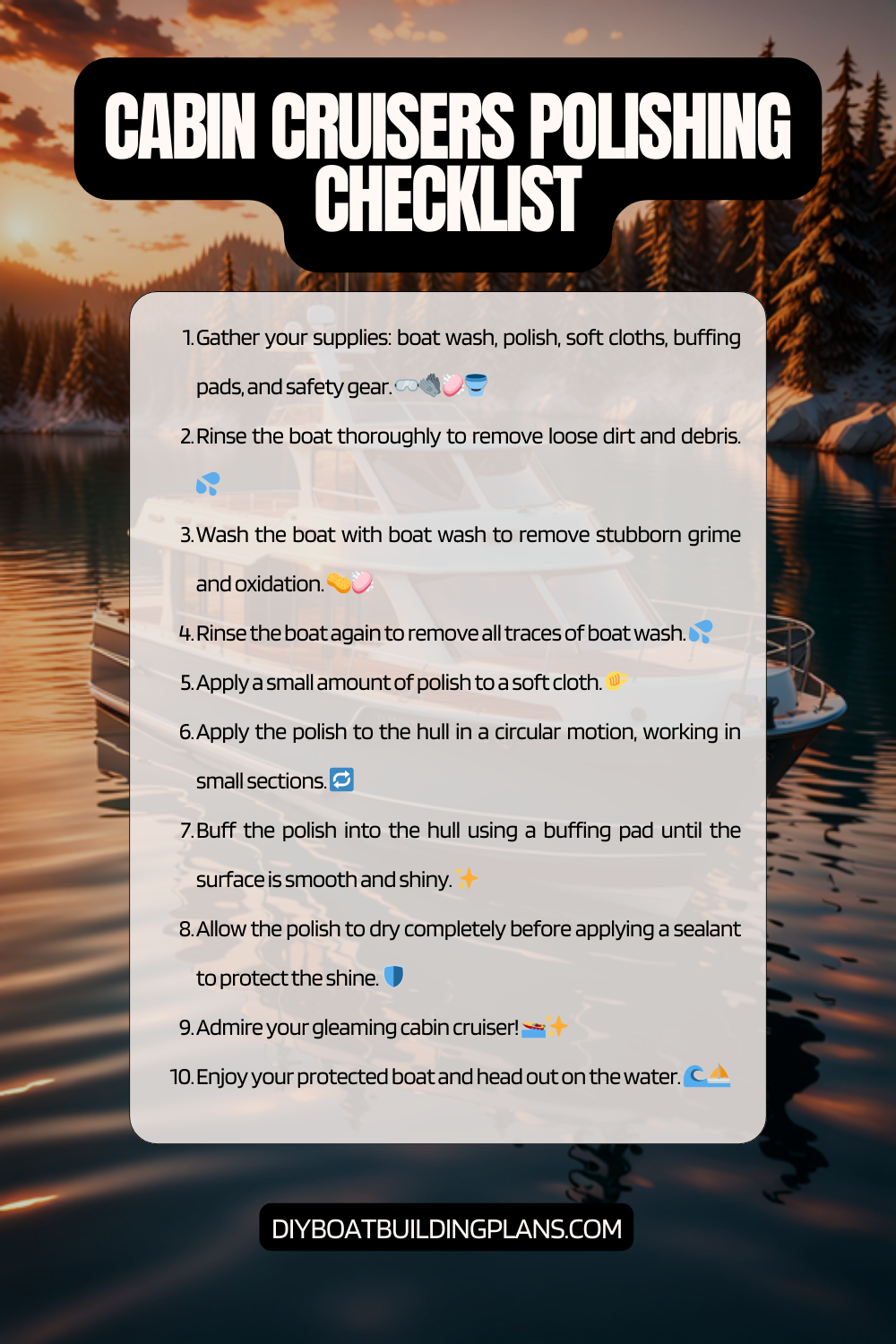Overview of Cabin Cruiser Polishing Tips
Cabin cruiser polishing refers to the process of cleaning, restoring, and maintaining the polished surfaces of a cabin cruiser boat. A cabin cruiser is a type of motorboat that is designed for leisure and recreational activities. It typically has a cabin or living space below deck, making it suitable for overnight stays or extended trips on the water.
Maintaining a polished cabin cruiser is essential for several reasons. Firstly, it helps to protect the boat from the damaging effects of environmental factors such as UV rays, saltwater, and pollutants. Secondly, a polished cabin cruiser enhances the overall appearance of the boat, making it more visually appealing and increasing its resale value. Lastly, regular polishing helps to extend the lifespan of the boat by preventing corrosion and deterioration of the surfaces.
Key Takeaways
- Polishing your cabin cruiser is important to maintain its appearance and protect it from damage.
- Choosing the right polishing products and preparing the surface properly are key to achieving a good result.
- Different surfaces require different polishing techniques, such as using a rotary buffer for fiberglass surfaces.
- When polishing stainless steel, chrome, and wood surfaces, it’s important to use the right products and techniques to avoid damage.
- Regular maintenance is necessary to keep your cabin cruiser’s polished surfaces looking their best.

Importance of Polishing Your Cabin Cruiser
Polishing your cabin cruiser offers numerous benefits that go beyond just aesthetics. One of the primary advantages is protection against environmental factors. The surfaces of a boat are constantly exposed to harsh elements such as UV rays from the sun, saltwater, and pollutants in the air. These factors can cause fading, oxidation, and corrosion over time. By regularly polishing your cabin cruiser, you create a protective barrier that shields the surfaces from these damaging effects.
In addition to protection, polishing also enhances the appearance of your boat. A well-polished cabin cruiser looks sleek, shiny, and well-maintained. This not only makes you proud as a boat owner but also leaves a positive impression on others who see your boat on the water. Whether you use your cabin cruiser for personal enjoyment or for entertaining guests, having a polished boat adds to the overall experience.
Choosing the Right Polishing Products
When it comes to choosing polishing products for your cabin cruiser, there are several factors to consider. Firstly, you need to determine the type of surfaces you will be polishing. Different materials require different products and techniques. For example, fiberglass surfaces require specific polishes that are designed to restore and protect the gel coat. Stainless steel surfaces, on the other hand, require polishes that remove oxidation and restore shine.
There are various types of polishing products available in the market, including compounds, polishes, and waxes. Compounds are used for heavy-duty cleaning and removing deep scratches or stains. Polishes are used to restore shine and remove light scratches, while waxes provide a protective layer and enhance the gloss. It is important to choose products that are specifically formulated for marine use, as they are designed to withstand the harsh marine environment.
Recommended polishing products for cabin cruisers include reputable brands such as 3M, Meguiar’s, and Collinite. These brands offer a wide range of products that cater to different surfaces and provide long-lasting protection.
Preparing Your Cabin Cruiser for Polishing
| Task | Frequency | Time Required |
|---|---|---|
| Clean the hull | Every 3 months | 2-3 hours |
| Wax the hull | Every 6 months | 4-6 hours |
| Polish the metal fittings | Every 6 months | 2-3 hours |
| Clean the deck | Every 2 weeks | 1-2 hours |
| Polish the windows | Every 3 months | 1-2 hours |
Before you start polishing your cabin cruiser, it is crucial to properly prepare the boat. This involves cleaning the boat thoroughly to remove any dirt, grime, or salt residue that may be present on the surfaces. Use a mild detergent or boat soap and a soft brush or sponge to clean the surfaces. Pay special attention to hard-to-reach areas such as corners and crevices.
If there are any stains or scratches on the surfaces, it is important to address them before polishing. Stains can be removed using specialized stain removers or by gently sanding the affected area with fine-grit sandpaper. Scratches can be buffed out using a compound or polish specifically designed for scratch removal.
After cleaning and addressing any stains or scratches, make sure to thoroughly dry the boat before proceeding with the polishing process. Moisture can interfere with the effectiveness of the polishing products and may cause streaks or water spots on the surfaces.
Polishing Techniques for Different Types of Surfaces
Different types of surfaces on a cabin cruiser require different polishing techniques to achieve optimal results. Fiberglass, stainless steel, chrome, and wood surfaces each have their own specific requirements.
For fiberglass surfaces, it is recommended to use a two-step process involving a compound and a polish. Start by applying a compound using a rotary buffer or a dual-action polisher. This will remove any oxidation, scratches, or imperfections in the gel coat. Follow up with a polish to restore shine and protect the surfaces. It is important to work in small sections and apply even pressure to ensure consistent results.
Stainless steel surfaces can be polished using a stainless steel cleaner or polish. Apply the product using a soft cloth or sponge, following the grain of the metal. Rub gently in circular motions until the desired shine is achieved. Avoid using abrasive materials or harsh chemicals that can damage the stainless steel.
Chrome surfaces can be polished using chrome-specific polishes or metal polishes that are safe for chrome. Apply the polish using a soft cloth or applicator pad, working in small sections. Buff the surface gently until the desired shine is achieved. Be careful not to apply too much pressure or use abrasive materials that can scratch the chrome.
Wood surfaces on a cabin cruiser require special care to maintain their natural beauty. Start by cleaning the wood with a mild detergent or wood cleaner to remove any dirt or grime. Once dry, apply a wood polish or wax using a soft cloth or applicator pad. Work in small sections, following the grain of the wood. Buff gently until the desired shine is achieved.
Tips for Polishing Fiberglass Surfaces
When polishing fiberglass surfaces on your cabin cruiser, it is important to use products that are specifically formulated for fiberglass restoration and protection. Look for products that contain UV inhibitors to prevent fading and yellowing of the gel coat.
To achieve optimal results, start by applying a compound using a rotary buffer or dual-action polisher. Work in small sections, applying even pressure and overlapping each pass to ensure consistent coverage. Once the compound has been applied, remove any residue using a clean microfiber cloth.
After the compound, apply a polish to restore shine and provide long-lasting protection. Again, work in small sections and apply even pressure. Buff the surface until the desired shine is achieved. It is important to avoid applying too much pressure or working for too long in one area, as this can cause heat buildup and damage the gel coat.
Common mistakes to avoid when polishing fiberglass surfaces include using abrasive materials or harsh chemicals that can scratch or damage the gel coat. It is also important to follow the manufacturer’s instructions and recommendations for each product to ensure optimal results.
Polishing Tips for Stainless Steel Surfaces
Stainless steel surfaces on a cabin cruiser can be polished to restore shine and remove oxidation or stains. When choosing polishing products for stainless steel, look for ones that are specifically formulated for marine use and are safe for stainless steel.
To polish stainless steel surfaces, start by applying a small amount of stainless steel cleaner or polish to a soft cloth or sponge. Rub the surface gently in circular motions, following the grain of the metal. Continue until the desired shine is achieved. It is important to avoid using abrasive materials or harsh chemicals that can scratch or damage the stainless steel.
After polishing, remove any residue using a clean microfiber cloth. This will ensure a streak-free finish and enhance the overall appearance of the stainless steel surfaces.
Common mistakes to avoid when polishing stainless steel surfaces include using abrasive materials or harsh chemicals that can scratch or damage the metal. It is also important to follow the manufacturer’s instructions and recommendations for each product to ensure optimal results.
Polishing Tips for Chrome Surfaces
Chrome surfaces on a cabin cruiser can be polished to restore shine and remove oxidation or stains. When choosing polishing products for chrome, look for ones that are specifically formulated for chrome or are safe for use on metal surfaces.
To polish chrome surfaces, start by applying a small amount of chrome polish or metal polish to a soft cloth or applicator pad. Rub the surface gently in circular motions, working in small sections. Continue until the desired shine is achieved. It is important to avoid using abrasive materials or harsh chemicals that can scratch or damage the chrome.
After polishing, remove any residue using a clean microfiber cloth. This will ensure a streak-free finish and enhance the overall appearance of the chrome surfaces.
Common mistakes to avoid when polishing chrome surfaces include using abrasive materials or harsh chemicals that can scratch or damage the chrome. It is also important to follow the manufacturer’s instructions and recommendations for each product to ensure optimal results.
Download over 500 Boat Plans. Click on the link below.
-->Click Here<--
Polishing Tips for Wood Surfaces
Wood surfaces on a cabin cruiser require special care to maintain their natural beauty and protect them from the elements. When choosing polishing products for wood, look for ones that are specifically formulated for marine use and are safe for wood surfaces.
To polish wood surfaces, start by cleaning the wood with a mild detergent or wood cleaner to remove any dirt or grime. Once dry, apply a small amount of wood polish or wax to a soft cloth or applicator pad. Work in small sections, following the grain of the wood. Buff gently until the desired shine is achieved.
After polishing, remove any residue using a clean microfiber cloth. This will ensure a streak-free finish and enhance the overall appearance of the wood surfaces.
Common mistakes to avoid when polishing wood surfaces include using abrasive materials or harsh chemicals that can scratch or damage the wood. It is also important to follow the manufacturer’s instructions and recommendations for each product to ensure optimal results.
Maintaining Your Cabin Cruiser’s Polished Surfaces
Once you have polished your cabin cruiser, it is important to maintain the polished surfaces to ensure they stay in optimal condition. This involves regular cleaning and polishing to remove dirt, grime, and salt residue that may accumulate over time.
Create a regular cleaning and polishing schedule to ensure that your cabin cruiser is properly maintained. Depending on the frequency of use and the environmental conditions, you may need to clean and polish your boat every few weeks or months. This will help to prevent the buildup of dirt and grime, as well as protect the surfaces from the damaging effects of environmental factors.
In addition to regular cleaning and polishing, it is important to protect the polished surfaces from environmental factors. This can be done by using boat covers or storing the boat in a covered area when not in use. UV rays, saltwater, and pollutants can cause fading, oxidation, and corrosion over time. By taking proactive measures to protect your cabin cruiser, you can extend the lifespan of the polished surfaces and maintain their optimal condition.
Cabin Cruiser Polishing Checklist

Conclusion – Cabin Cruiser Polishing Tips
In conclusion, cabin cruiser polishing is an essential part of maintaining your boat’s appearance and protecting its surfaces from environmental factors. By regularly polishing your cabin cruiser, you can enhance its overall appearance, protect it from UV rays and saltwater, and extend its lifespan.
When choosing polishing products for your cabin cruiser, consider the type of surfaces you will be polishing and choose products that are specifically formulated for marine use. Follow the recommended techniques for each type of surface to achieve optimal results and avoid common mistakes that can damage the surfaces.
Maintaining the polished surfaces of your cabin cruiser requires regular cleaning and polishing, as well as protecting them from environmental factors. By following a regular maintenance schedule and taking proactive measures to protect your boat, you can ensure that your cabin cruiser remains in optimal condition for years to come.
FAQs – Cabin Cruiser Polishing Tips
What is a cabin cruiser?
A cabin cruiser is a type of powerboat that is designed for leisure activities such as cruising, fishing, and water sports. It typically has a cabin or living quarters below deck.
Why is polishing important for a cabin cruiser?
Polishing is important for a cabin cruiser because it helps to maintain the boat’s appearance and protect the gelcoat from damage caused by UV rays, saltwater, and other environmental factors.
What materials are needed for cabin cruiser polishing?
Materials needed for cabin cruiser polishing include a polishing compound, a buffing pad, a polishing pad, a microfiber towel, and a power buffer or polisher.
How often should a cabin cruiser be polished?
The frequency of polishing a cabin cruiser depends on how often it is used and the conditions it is exposed to. Generally, it is recommended to polish a boat at least once a year, but it may need to be done more frequently if it is used frequently or exposed to harsh conditions.
What are some tips for polishing a cabin cruiser?
Some tips for polishing a cabin cruiser include starting with a clean surface, working in small sections, using a light touch, and avoiding direct sunlight or high temperatures. It is also important to follow the manufacturer’s instructions for the polishing compound and equipment.



